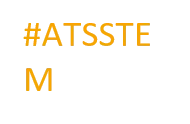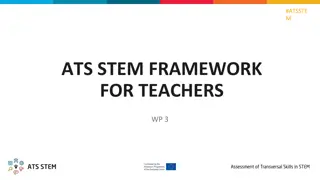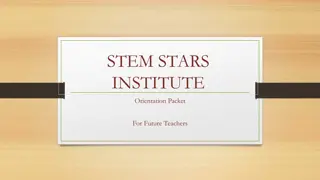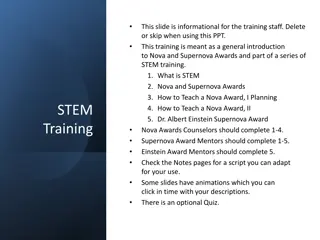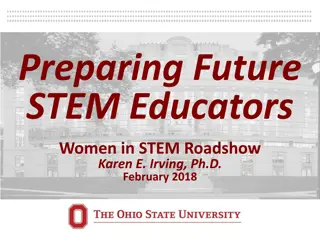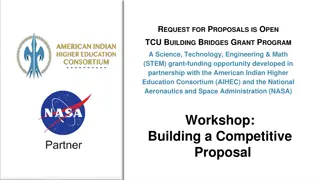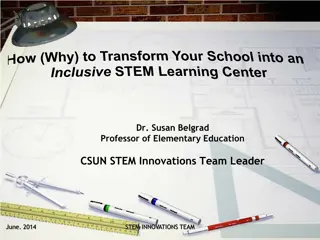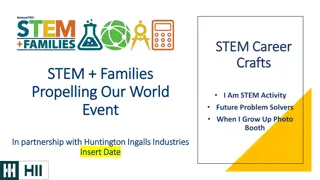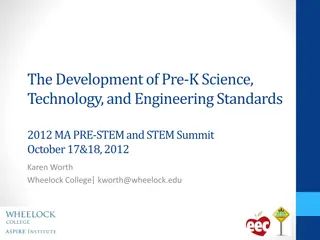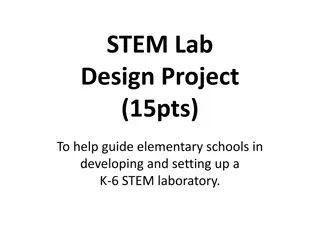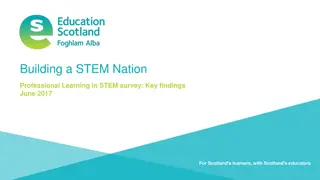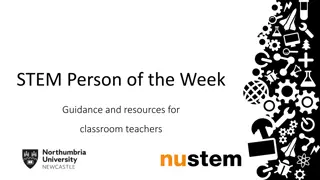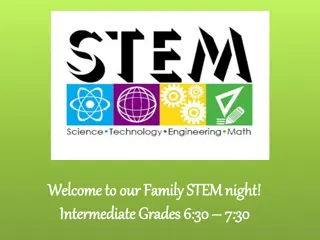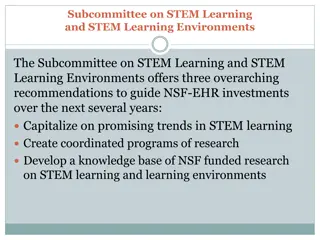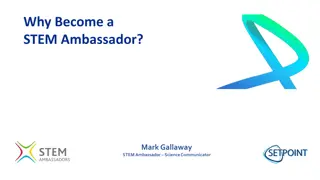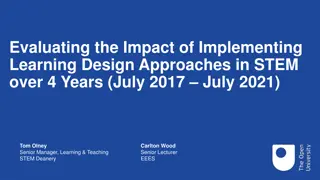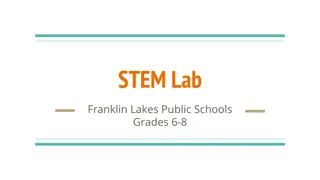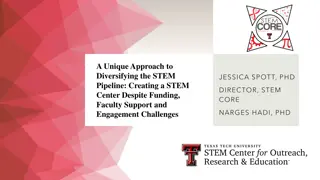Implementing STEM Activities for Teacher Development
This guide provides a structured approach for educators to design and implement STEM activities, focusing on starting points, design templates, formative assessment strategies, success criteria, and reflection. It emphasizes developing transversal competencies and encourages multiple rounds of activities to enhance teacher and student learning outcomes.
Download Presentation

Please find below an Image/Link to download the presentation.
The content on the website is provided AS IS for your information and personal use only. It may not be sold, licensed, or shared on other websites without obtaining consent from the author. Download presentation by click this link. If you encounter any issues during the download, it is possible that the publisher has removed the file from their server.
E N D
Presentation Transcript
#ATSSTE M ATS STEM IMPLEMENTATION DESIGN FOR TEACHERS WP 3
#ATSSTE M Firstly, you need to know the starting point.
#ATSSTE M Starting point Duration of lessons Number and year level of students Teacher( s) responsible Subjects / topics involved Total amount of lessons during the implementation Artefacts produced during the implementation
#ATSSTE M Secondly, you need to master the design template.
Defining learning intentions Defining learning intentions #ATSSTE M Subjects / topics Subjects / topics Transversal competencies (same as in STEM activity 1) Transversal competencies STEM ACTIVITY 1 STEM ACTIVITY 2 REFLECTION Defining formative assessment strategies and digitals tools Defining formative assessment strategies and digitals tools Defining success criteria Defining success criteria Designing assessment Designing assessment
#ATSSTE M How to read the design template? Design and implement STEM activity 1. Reflect on how it went: how well did the students develop the transversal competencies set as learning intentions. Design and implement STEM activity 2 that aims to develop the same competencies as the first round. Implement round 2 with the same group of students. STEM activity 2 does not have to a further developed version of STEM activity 1 - it can be its own independent activity, as long as it promotes the same transversal competencies as the STEM activity 1.
#ATSSTE M How to read the design template? The template presents two rounds of activities. This is the minimum amount in ATS STEM project.
#ATSSTE M How to read the design template? However, if wanted, the schools are allowed to design and implement three or more rounds of activities.
#ATSSTE M Checklist for STEM principles Remember to also follow the ATS STEM principles. You do not have to acknowledge all the principles during each activity. However, you need to make sure that all boxes will be ticked during the two (or more) activities. Problem Solving Design and Approaches Disciplinary and Interdisciplinary Knowledge Engineering Design and Practices Appropriate Use and Application of Technology Real-world Contexts Appropriate Pedagogical Practices
#ATSSTE M Defining learning intentions Defining learning intentions Subjects / topics Subjects / topics Transversal competencies (same as in STEM activity 1) Transversal competencies STEM ACTIVITY 1 STEM ACTIVITY 2 REFLECTION Defining formative assessment strategies and digitals tools Defining formative assessment strategies and digitals tools Defining success criteria Defining success criteria Designing assessment Designing assessment
#ATSSTE M Instructions: learning intentions Targeted transversal competencies Define the transversal competency-related learning intentions you will be formatively assessing with a selection of digital tools. Remember to not only mention the title, eg communication or critical thinking, but in a more detailed way specify what you are expecting the students to learn, and consequently, what is going to be assessed. For the best result, it is recommended to choose a moderate amount of targeted transversal competencies (2-3) to be formatively assessed with digital tools.
#ATSSTE M Instructions: learning intentions Targeted transversal competencies Several competencies that can be developed during the activity, however, it is important to carefully specify the targeted transversal competencies that will be formatively assessed with digital tools. You can use the analogy of sports to understand this: When assessing a long jump performance, you have the run up, takeoff, flight and landing. When targeting to assess takeoff, a coach will choose an assessment strategy to pay special attention to takeoff. The coach will choose eg to use video program to record the takeoff, in order to analyse it more carefully. The athlete will still perform all the phases of the long jump, but the coach will focus particularly on assessing the takeoff.
#ATSSTE M Instructions: learning intentions Other learning intentions Define all other learning intentions related to the STEM subjects or competencies. Note that all learning intentions must be communicated in a student-friendly way - it is important that both teachers and students understand the learning intentions of the activity.
Defining learning intentions Defining learning intentions #ATSSTE M Subjects / topics Subjects / topics Transversal competencies (same as in STEM activity 1) Transversal competencies STEM ACTIVITY 1 STEM ACTIVITY 2 REFLECTION Defining formative assessment strategies and digitals tools Defining formative assessment strategies and digitals tools Defining success criteria Defining success criteria Designing assessment Designing assessment
#ATSSTE M Instructions: STEM activity Defining a real world problem related to SDG s The activity must follow the steps presented here. Discussing solution(s) Finding solution(s) Assessing solution(s) Trialing solution(s)
#ATSSTE M Defining a real world problem related to SDG s Introduce the United Nation Sustainable Development Goals to the students. What: the goals of sustainable development. All goals are important and interconnected. In other words, one goal cannot be achieved without another. Who: Goals are relevant for all of us: countries, municipalities, businesses, schools, you and me. Everyone can participate with their choices and by disseminating information about the goals and by promoting political decision making as a way to a better future. Why: to make the world a better place for us all, acknowledging points of view of environment, human rights and economic. Decide the SDG goals you are going to pay special attention to in this activity.
#ATSSTE M
#ATSSTE M Instructions: STEM activity Defining a real world problem related to SDG s The activity must follow the steps presented here. Discussing solution(s) Finding solution(s) Assessing solution(s) Trialing solution(s)
#ATSSTE M Finding solutions Design how the students will be guided to find solutions to real world problems related to the SDGs.
#ATSSTE M Instructions: STEM activity Defining a real world problem related to SDG s The activity must follow the steps presented here. Discussing solution(s) Finding solution(s) Assessing solution(s) Trialing solution(s)
#ATSSTE M Trialing solutions Design how the students will be guided to trial the solutions they have developed.
#ATSSTE M Instructions: STEM activity Defining a real world problem related to SDG s The activity must follow the steps presented here. Discussing solution(s) Finding solution(s) Assessing solution(s) Trialing solution(s)
#ATSSTE M Assessing solutions Design how the students will be guided to assess the solutions they developed and trialed.
#ATSSTE M Instructions: STEM activity Defining a real world problem related to SDG s The activity must follow the steps presented here. Discussing solution(s) Finding solution(s) Assessing solution(s) Trialing solution(s)
#ATSSTE M Discussing solutions Design how the students will be guided to discuss solutions they developed, trialed and assessed.
#ATSSTE M The extent of an activity Teachers decide the number of lessons spend to implement an activity.
#ATSSTE M Defining learning intentions Defining learning intentions Subjects / topics Subjects / topics Transversal competencies (same as in STEM activity 1) Transversal competencies STEM ACTIVITY 1 STEM ACTIVITY 2 REFLECTION Defining formative assessment strategies and digitals tools Defining formative assessment strategies and digitals tools Defining success criteria Defining success criteria Designing assessment Designing assessment
#ATSSTE M Instructions: define success criteria for targeted transversal competencies For example, if you choose the transversal competence-related learning intention to be communication skills, and more specifically to negotiate and balance diverse views and beliefs to reach workable solutions , this is how you might want to create the success criteria for it. Attempting Developing Mastery Advanced You regularly participate aggressively to stand your ground when diverse views and beliefs are in play You regularly participate timidly or reluctantly in all efforts to reach compromise when diverse views and beliefs are in play You regularly participate fully in all efforts to reach compromise when diverse views and beliefs are in play. You regularly take the initiative in efforts to reach compromise when diverse views and beliefs are in play
#ATSSTE M Instructions: define assessment strategy and digital tools Which digital tools are you going to use to formatively assess students success in relation to the targeted transversal competencies set as learning intentions? Name and place the digital tools in the table. For example, if you are planning to use Padlet in creating classroom discussion, place the name as demonstrated below. Functions of digital tools Sending and/or Displaying Analysing and/or Processing Interactive environment Formative assessment strategies Sharing learning intentions Clarifying success criteria Questioning Classroom discussions Padlet Giving feedback Using feedback Self-assessment Peer assessment
#ATSSTE M Thirdly, you need to make a schedule.
Implementation schedule #ATSSTE M Lesson no Date and time Short description of the lesson Which step this lesson is related to Targeted competencies Formative assessment strategies Digitals tool(s) utilized
#ATSSTE M After the implementation of STEM activity 1, you need to take time to reflect
#ATSSTE M Defining learning intentions Defining learning intentions Subjects / topics Subjects / topics Transversal competencies (same as in STEM activity 1) Transversal competencies STEM ACTIVITY 1 STEM ACTIVITY 2 REFLECTION Defining formative assessment strategies and digitals tools Defining formative assessment strategies and digitals tools Defining success criteria Defining success criteria Designing assessment Designing assessment
#ATSSTE M Instructions: reflection Formative assessment is a cyclical process involving the elicitation of evidence, interpretation of evidence, and action based on that evidence. Take a moment to reflect, eg what is my understanding of the student s competencies targeted during STEM activity 1? how well did the digital assessment tools work in order to assess the targeted competencies? how would I better support the development of targeted competencies in the STEM activity 2?
#ATSSTE M After reflection, it is time to start designing the STEM activity 2.
#ATSSTE M Defining learning intentions Defining learning intentions Subjects / topics Subjects / topics Transversal competencies (same as in STEM activity 1) Transversal competencies STEM ACTIVITY 1 STEM ACTIVITY 2 REFLECTION Defining formative assessment strategies and digitals tools Defining formative assessment strategies and digitals tools Defining success criteria Defining success criteria Designing assessment Designing assessment
#ATSSTE M Instructions: learning intentions For STEM activity 2, target the same transversal competencies as for STEM activity 1. Define other learning intentions for STEM activity 2. These can, and likely will be, different to those for STEM activity 1.
#ATSSTE M Defining learning intentions Defining learning intentions Subjects / topics Subjects / topics Transversal competencies (same as in STEM activity 1) Transversal competencies STEM ACTIVITY 1 STEM ACTIVITY 2 REFLECTION Defining formative assessment strategies and digitals tools Defining formative assessment strategies and digitals tools Defining success criteria Defining success criteria Designing assessment Designing assessment
#ATSSTE M Instructions: STEM activity Defining a real world problem related to SDG s The activity must again follow the steps presented here. Discussing solution(s) Finding solution(s) Assessing solution(s) Trialing solution(s)
#ATSSTE M Defining learning intentions Defining learning intentions Subjects / topics Subjects / topics Transversal competencies (same as in STEM activity 1) Transversal competencies STEM ACTIVITY 1 STEM ACTIVITY 2 REFLECTION Defining formative assessment strategies and digitals tools Defining formative assessment strategies and digitals tools Defining success criteria Defining success criteria Designing assessment Designing assessment
#ATSSTE M Instructions: define success criteria for transversal competencies The targeted transversal competencies are the same as in STEM activity 1. Hence, you can use the same success criteria.
#ATSSTE M Instructions: define assessment strategy and digital tools You can choose different strategies and tools compared to the STEM activity 1. Functions of digital tools Sending and/or Displaying Analysing and/or Processing Interactive environment Formative assessment strategies Sharing learning intentions Clarifying success criteria Questioning Classroom discussions Giving feedback Using feedback Self-assessment Peer assessment
#ATSSTE M Remember! The focus of ATS STEM project is to investigate the possibilities of formative assessment with digital tools in the context of STEM. You can design and implement other types of assessment related to the STEM activities, however, you need to make sure that in each activity you: SPECIFY 2-3 TARGETED TRANSVERSAL COMPETENCY-RELATED LEARNING INTENTIONS DEFINE SUCCESS CRITERIA FOR THE TARGETED TRANSVERSAL COMPETENCY-RELATED LEARNING INTENTIONS CHOOSE SUITABLE FORMATIVE ASSESSMENT STRATEGIES AND DIGITAL TOOLS TO BE UTILISED IN SUPPORTING THE STUDENT LEARNING RELATED TO THE TARGETED TRANSVERSAL COMPETENCIES
#ATSSTE M And again, you must plan a schedule for the implementation.
Implementation schedule #ATSSTE M Lesson no Date and time Short description of the lesson Which step this lesson is related to Targeted competencies Formative assessment strategies Digitals tool(s) utilized
#ATSSTE M LET S TAKE A LOOK AT AN EXAMPLE
#ATSSTE M Starting point Duration of lessons: 60 min each Number and year level of students: 25 students of year 8 Teachers responsible: 1 mathematics teacher and 1 science teacher Subjects / topics involved mathematics, science Total amount of lessons during the implementation 4 lessons Artefacts produced during the implementation self-assessment of the competencies, self-assessment of the solutions, peer-assessment of classmates solutions, water saving solutions built in teams
#ATSSTE M Learning intentions Targeted transversal competencies Title: problem-solving skills Specification: to evaluate best solutions Title: communication skills Specification: to negotiate and balance diverse views and beliefs to reach workable solutions
#ATSSTE M Learning intentions Other learning intentions are to guide the students in estimating the magnitude of a measured object, selecting a suitable tool and unit for the measurement, and considering whether the result is reasonable to develop his or her scientific thinking skills and understanding of causal relationships to conduct experimental research in cooperation with others and to work safely and consistently to process, interpret, and present the results of his or her own research and to evaluate them and the entire research process to conduct experimental research in cooperation with others and to work safely and consistently to understand the operating principles and significance of technological applications and to inspire the pupil to participate in forming ideas for simple technological solutions and designing, developing, and applying them in cooperation with others
#ATSSTE M Defining success criteria for the targeted transversal competencies Title: problem-solving skills Specification: to evaluate best solutions Attempting Developing Mastery Advanced You are unable to determine the accuracy of solutions and reflect on possible issues and limitations of a solution without a great deal of assistance. You determine whether the solutions are accurate and reflect on possible issues and limitations of a solution with assistance. You determine whether the solutions are accurate and reflect on possible issues and limitations of a solution with little assistance. You determine whether the solutions are accurate and reflect on possible issues and limitations of a solution with no assistance.


